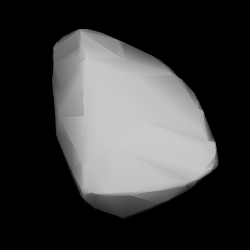Astronomy:3325 TARDIS
 Shape model of TARDIS from its lightcurve | |
| Discovery [1] | |
|---|---|
| Discovered by | B. A. Skiff |
| Discovery site | Anderson Mesa Stn. |
| Discovery date | 3 May 1984 |
| Designations | |
| (3325) TARDIS | |
| Named after | TARDIS (fictional time machine)[2] |
| 1984 JZ · 1958 VB1 1969 TP3 · 1975 VC8 1975 WF1 | |
| Minor planet category | main-belt [1] · (outer) Alauda [3] |
| Orbital characteristics [1] | |
| Epoch 4 September 2017 (JD 2458000.5) | |
| Uncertainty parameter 0 | |
| Observation arc | 58.56 yr (21,390 days) |
| |{{{apsis}}}|helion}} | 3.2299 AU |
| |{{{apsis}}}|helion}} | 3.1397 AU |
| 3.1848 AU | |
| Eccentricity | 0.0142 |
| Orbital period | 5.68 yr (2,076 days) |
| Mean anomaly | 45.895° |
| Mean motion | 0° 10m 24.24s / day |
| Inclination | 22.221° |
| Longitude of ascending node | 46.246° |
| 86.099° | |
| Physical characteristics | |
| Mean diameter | 28.238±0.469 km[4] 29.66±1.2 km (IRAS:9)[5] |
| Geometric albedo | 0.0553±0.005 (IRAS:9)[5] 0.067±0.010[4] |
| Absolute magnitude (H) | 11.5[1] |
3325 TARDIS (prov. designation: 1984 JZ) is a dark Alauda asteroid from the outer region of the asteroid belt, approximately 29 kilometers (18 miles) in diameter. It was discovered on 3 May 1984, by American astronomer Brian Skiff at Lowell's Anderson Mesa Station, Arizona, in the United States.[6] The asteroid was named TARDIS, after the fictional time machine and spacecraft from the science fiction television series Doctor Who.[2]
Orbit and classification
TARDIS is a member of the Alauda family (902),[3] a large family of typically bright carbonaceous asteroids and named after its parent body, 702 Alauda.[7]:23
It orbits the Sun in the outer main-belt at a distance of 3.1–3.2 AU once every 5 years and 8 months (2,076 days). Its orbit has an eccentricity of 0.01 and an inclination of 22° with respect to the ecliptic.[1] In 1958 it was first identified as 1958 VB1 at the Goethe Link Observatory, extending the body's observation arc by 26 years prior to its official discovery at Anderson Mesa.[6]
Naming
It is named after the acronym TARDIS (Time And Relative Dimension In Space), the space and time travel vehicle used by the Doctor in the British science fiction television series Doctor Who. The fictional time machine looks like a police telephone box from mid-twentieth century Britain.[2] The official naming citation was published by the Minor Planet Center on 11 March 1990 (M.P.C. 16041).[8]
Physical characteristics
According to the survey carried out by the Infrared Astronomical Satellite IRAS and NASA's NEOWISE mission, TARDIS measures 28.2 and 29.7 kilometers in diameter, and its surface has a low albedo of 0.055 and 0.067, respectively.[4][5] An albedo between 0.05 and 0.06 is typical for carbonaceous asteroids of the outer main-belt. As of 2016, no rotational lightcurves have been obtained and the asteroid's period and shape still remains unknown.
References
- ↑ 1.0 1.1 1.2 1.3 1.4 "JPL Small-Body Database Browser: 3325 TARDIS (1984 JZ)". Jet Propulsion Laboratory. https://ssd.jpl.nasa.gov/sbdb.cgi?sstr=2003325.
- ↑ 2.0 2.1 2.2 Schmadel, Lutz D. (2007). "(3325) Tardis". Dictionary of Minor Planet Names. Springer Berlin Heidelberg. p. 277. doi:10.1007/978-3-540-29925-7_3326. ISBN 978-3-540-00238-3. https://archive.org/details/dictionaryminorp00schm.
- ↑ 3.0 3.1 "Asteroid 3325 TARDIS – Nesvorny HCM Asteroid Families V3.0". Small Bodies Data Ferret. https://sbntools.psi.edu/ferret/SimpleSearch/results.action?targetName=3325+TARDIS#Asteroid%203325%20TARDISEAR-A-VARGBDET-5-NESVORNYFAM-V3.0.
- ↑ 4.0 4.1 4.2 Masiero, Joseph R.; Grav, T.; Mainzer, A. K.; Nugent, C. R.; Bauer, J. M.; Stevenson, R. et al. (August 2014). "Main-belt Asteroids with WISE/NEOWISE: Near-infrared Albedos". The Astrophysical Journal 791 (2): 11. doi:10.1088/0004-637X/791/2/121. Bibcode: 2014ApJ...791..121M. http://adsabs.harvard.edu/cgi-bin/bib_query?bibcode=2014ApJ...791..121M. Retrieved 5 December 2016.
- ↑ 5.0 5.1 5.2 Tedesco, E. F.; Noah, P. V.; Noah, M.; Price, S. D. (October 2004). "IRAS Minor Planet Survey V6.0". NASA Planetary Data System 12: IRAS-A-FPA-3-RDR-IMPS-V6.0. Bibcode: 2004PDSS...12.....T. https://sbnarchive.psi.edu/pds3/iras/IRAS_A_FPA_3_RDR_IMPS_V6_0/data/diamalb.tab. Retrieved 22 October 2019.
- ↑ 6.0 6.1 "3325 TARDIS (1984 JZ)". Minor Planet Center. https://www.minorplanetcenter.net/db_search/show_object?object_id=3325.
- ↑ Nesvorný, D.; Broz, M.; Carruba, V. (December 2014). "Identification and Dynamical Properties of Asteroid Families". Asteroids IV. pp. 297–321. doi:10.2458/azu_uapress_9780816532131-ch016. ISBN 9780816532131. Bibcode: 2015aste.book..297N.
- ↑ "MPC/MPO/MPS Archive". Minor Planet Center. https://www.minorplanetcenter.net/iau/ECS/MPCArchive/MPCArchive_TBL.html.
External links
- Lightcurve Database Query (LCDB), at www.minorplanet.info
- Dictionary of Minor Planet Names, Google books
- Asteroids and comets rotation curves, CdR – Geneva Observatory, Raoul Behrend
- Discovery Circumstances: Numbered Minor Planets (1)-(5000) – Minor Planet Center
- 3325 TARDIS at AstDyS-2, Asteroids—Dynamic Site
- 3325 TARDIS at the JPL Small-Body Database
 |

